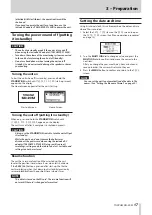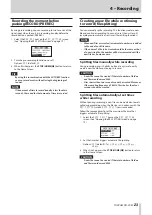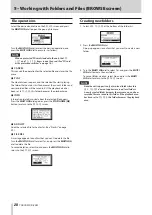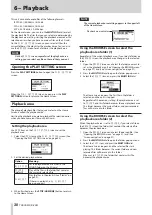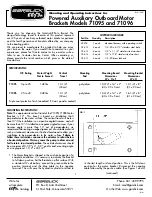
TASCAM SD-20M
15
3 – Preparation
Connecting other equipment
This is an example of SD-20M connections.
ANALOG
IN
(UNBALANCED)
L
R
ANALOG
OUT
(UNBALANCED)
L
R
Headphones
Mixer, recorder, amplifier, etc.
TASCAM RC-3F (sold separately)
TASCAM RC-10 (sold separately)
Mic
Examples of connections to an SD-20M
CAUTION
•
Carefully read the operation manuals of the devices to be connected and then connect them correctly.
•
Before making connections, turn this unit and all equipment to be connected off (or put them into standby).
•
Install all connected devices, including this unit, so that they are powered from the same line. When using a power strip or similar
device, be sure to use one that has high current capacity (thick cable) in order to minimize fluctuations in power voltage.
•
The phantom power sets two input channels at a time. Do not turn phantom power on when connecting an unbalanced dynamic
mic.
•
Do not connect or disconnect mics while phantom power is on. Doing so could cause a loud noise and might damage this unit and
connected equipment.
•
Supplying phantom power to some ribbon mics will break them. If you are unsure, do not supply phantom power to a ribbon mic.
•
Set the
PHONES
knob to its minimum value before changing a phantom power setting. Failure to do so could cause sudden loud
noises from monitoring equipment, and this could damage equipment or harm hearing.
•
Reduce the output level of the external audio device if the input sound is distorted even when reducing the input gain level on the
unit.
•
When an external audio device with a fixed line output level is connected, level overloads might occur and adjusting the gain level
might not be possible because of loud sound sources, for example. In such cases, use the headphone jack or another level-control-
lable output for connection to the unit.

















